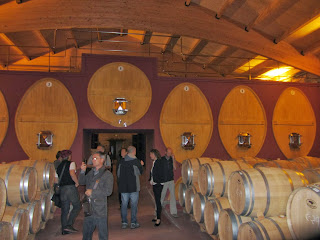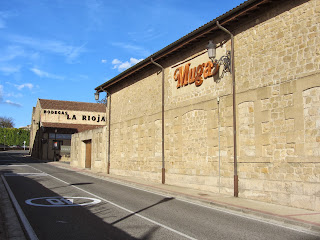 |
| Hotel Arrope (Source: rioja.on-map.net) |
Gomez Cruzado is located in the Station District of Haro, an area around the old train station which is home to the majority of the region's centenarian wineries (over 100 years old) and which was initiated with the founding of Viña Tondonia in 1877. As we passed Viña Tondonia, we stopped at their loading dock to watch overall-clad workers unloading grapes brought to the winery by tractor and housed in ancient rounded, tapered, open-top barrels.
Gomez Cruzado is located just across the street from Tondonia. We were welcomed at the winery by Noemi Arenzana Ruiz and a colleague (during the course of the visit, technical experts flowed in and out as needed with Juan Martinez and David Marcos (enologist and viticulturist, plus operations and strategy setting) staying for the duration post their initial contact with the group) and they proceeded to give us some background.
Gomez Cruzado, at 200,000 bottles annually (capacity at 400,000), is the smallest winery in the region. It was founded in 1886 by D. Ángel Gómez de Artache, Duke of Montezuma, and was subsequently acquired by D. Angel and D. Jesus Gomez Cruzado in 1911. In 1991, the then Public Limited Company (since 1951) was purchased by four partners who sold it in 2003. The most recent transaction occurred in 2012 when the winery was purchased by a Mexican family.
Gomez Cruzado does not currently own any vineyards. Rather, they buy grapes -- 50% of which is procured from small, family-owned vineyards -- that are grown on over 100 separate plots. They assist in the management of the plots from which their grapes are sourced -- especially in the month prior to harvest -- and establish the harvesting criteria and schedule. To positively impact the quality of the grapes, leaf-thinning and green harvesting are practiced. Gomez Cruzado prefers later-maturing grapes with hard skins (as a protection against botrytis). All grapes are hand-picked and are selected from the lower portion of the bunch. The tendency is to pick on attainment of brown pips as well as taste.
Wines are fermented in stainless steel tanks. The preferred style of wine is a classic Rioja with fruit that is approachable earlier. Grapes are de-stemmed, cold-soaked, and then subjected to an 18- to 20-day alcoholic fermentation using natural yeasts. The wine is blended prior to oak aging.
Wines are stored in the cellar between 1 and 5 years, the first 5 to 6 months of which is in oak vats. The Crianza is aged for 12 months in (average) 2.5-year-old American oak (oak barrels are generally used for 5 years). The Reserva spends 18 months in oak and 18 months in bottle. The Gran Reserva spends 24 months in oak and 36 months in bottle. The winery produces a Crianza Reserva Special Selection where the wines are aged in barrels and then blended prior to bottling.
Most of the Gomez Cruzado wines are Tempranillo-Garnacha (cool-climate) blends of grapes sourced from Rioja Alta and Rioja Alavesa. The strategy team is looking to move the winery deeper into terroir-based wines.
Of the 200,000 bottle production, 85% is destined for the export market with the UK and Mexico very important destinations. There is currently no US distribution.
At this time we concluded the winery tour and moved inside for the tasting and a light lunch. The lunch consisted of various hams and breads and (heavenly) large chunks of morcilla. The wines were tasted as we ate.
The first wine on offer was the 2009 Crianza. On the nose plum, rose, vanilla, coffee, red pepper, cinnamon, and clove. It says Rioja. On the palate succulent, clean, and persistent. Clean. Easy drinking, but not simple.
The 2007 Reserva was aged in American and French oak for 18 months. Vanilla and clove on the nose. Promise on the nose but does not deliver. The tannins and acid are overtaking the fruit at this time. Weighty on the palate but light finish. Unbalanced. Not yet fully integrated.
The Honorable 2007 is 100% Tempranillo. On the nose red fruit, baking spices, and red pepper. Deep in color but light on feet. Persistence and balance with long finish. The 2010 Honorable exhibits black fruit and a spicy nose. Needs another year in bottle.
The Vendemia Seleccionada 2012 is a Tempranillo/Garnacha blend which is aimed at recapturing the youth market. The wine spends 6 months in new French oak and then those barrels are used for the Honorable wine. The aging regime used for this wine is non-compliant with the official directives. This wine is dark in color. Austere nose with meaty undertones and hints of darker fruit, pine, spice, and a creaminess. Balanced. Concentrated in glass and on palate.
The 2011 Pancrudo is the first vintage of this wine. It is 100% Garnacha made with grapes sourced from Sierra, one of the most important terrors in the region for grape production. This is a special terroir and a special grape. It is fermented for 14 days with malolactic fermentation in new French oak. It is matured in French oak for one year after which it is transferred to bottle and aged for an additional 6 months. Production is currently at 2000 bottles. Red fruit on the nose, black fruit on the palate. Citrus, burnt orange rind. Silky smooth with medium tannin and alcohol. Easy drinking, fresh, round, and balanced.
This is small winery, as the staffers are quick to point out. There are a total of 7 employees so everyone has to wear a number of hats and work very hard. On a number of evenings I saw the two principals grabbing a coffee at the hotel either very early in the morning or late at night as they planned production activities or supervised late night harvesting/winemaking activities. It was a pleasure to watch the level of cooperation between the two leaders as they have taken on joint responsibility, not only for production of the wines, but, also, the strategic direction of the winery as an entity. The level of interaction and cooperation is, again, refreshing.
This winery is not giving up on the youth market. While many sit around and wail that the young folks prefer spirits, beer, or water, this winery is experimenting with product that could appeal to these "wayward" youngsters. They are also pursuing terroir-based wines, one of the areas in which Rioja has lagged behind the rest of the Old World. Gomez Cruzado is not allowing its size -- or lack of same -- get in the way of pursuing initiatives which keeps the winery among the vanguard of Rioja wine producers.
In closing I would like to thank the entire team at Gomez Cruzado for their hospitality, kindness, and openness, hallmarks, as I came to find out, of winemaking in Haro.
©Wine -- Mise en abyme




















































